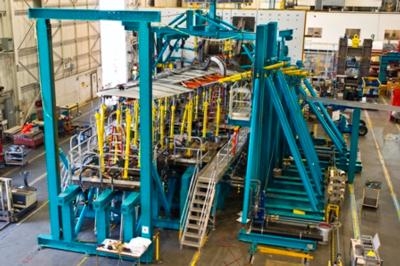Tue, Sep 04, 2012
USAF Hopes To Fly The Aircraft Until At Least 2050
A five-year testing program is underway on the wing of a U.S. Air Force B-1 bomber to validate the predicted life of the bomber fleet, currently expected to be 2050. The testing is being carried out by Boeing. The test also will reveal potential areas of concern for which Boeing and the Air Force can develop maintenance and repair plans.

"This comprehensive testing is a proactive way for Boeing to meet its mission of keeping the B-1 bomber fleet ready and viable," said Rick Greenwell, Boeing B-1 program director.
Boeing and the Air Force also plan to fatigue-test a B-1 fuselage at Boeing Tukwila beginning in November 2013.
The B-1A was initially developed in the 1970s as a replacement for the B-52. Four prototypes of this long-range, high speed (Mach 2.2) strategic bomber were developed and tested in the mid-1970s, but the program was canceled in 1977 before going into production. Flight testing continued through 1981.
The B-1B is an improved variant initiated by the Reagan administration in 1981. Major changes included the addition of additional structure to increase payload by 74,000 pounds, an improved radar and reduction of the radar cross section by an order of magnitude. The inlet was extensively modified as part of this RCS reduction, necessitating a reduction in maximum speed to Mach 1.2.
The first production B-1 flew in October 1984, and the first B-1B was delivered to Dyess Air Force Base, Texas, in June 1985. Initial operational capability was achieved on Oct. 1, 1986. The final B-1B was delivered May 2, 1988. The U.S. Air Force says B-1 is the backbone of America's long-range bomber force. It can rapidly deliver massive quantities of precision and non-precision weapons against any adversary, anywhere in the world, at any time.
(Image of wing test mechanism provided by Boeing)
More News
Also: Netherlands Donates 18 F16s, 2 737s Collide On Ramp, E-7 Wedgetail Cut, AgEagle's 100th In S Korea The Pilot and Aircraft Privacy Act was introduced in the House by Represent>[...]
Pilot Also Reported That Due To A Fuel Leak, The Auxiliary Fuel Tanks Were Not Used On June 4, 2025, at 13:41 eastern daylight time, a Piper PA-23, N2109P, was substantially damage>[...]
Have A Story That NEEDS To Be Featured On Aero-News? Here’s How To Submit A Story To Our Team Some of the greatest new stories ANN has ever covered have been submitted by our>[...]
From 2023 (YouTube Edition): Reflections on War’s Collective Lessons and Cyclical Nature The exigencies of war ought be colorblind. Inane social-constructs the likes of racis>[...]
What Goes Around, May Yet Come Back Around, Klyde FMI: www.klydemorris.com>[...]
 Airborne 06.30.25: US v ADS-B Misuse, Natl STOL Fire, Volocopter Resumes
Airborne 06.30.25: US v ADS-B Misuse, Natl STOL Fire, Volocopter Resumes NTSB Prelim: Piper PA-23
NTSB Prelim: Piper PA-23 ANN FAQ: Submit a News Story!
ANN FAQ: Submit a News Story! Classic Aero-TV: One Mans Vietnam
Classic Aero-TV: One Mans Vietnam Klyde Morris (06.30.25)
Klyde Morris (06.30.25)



